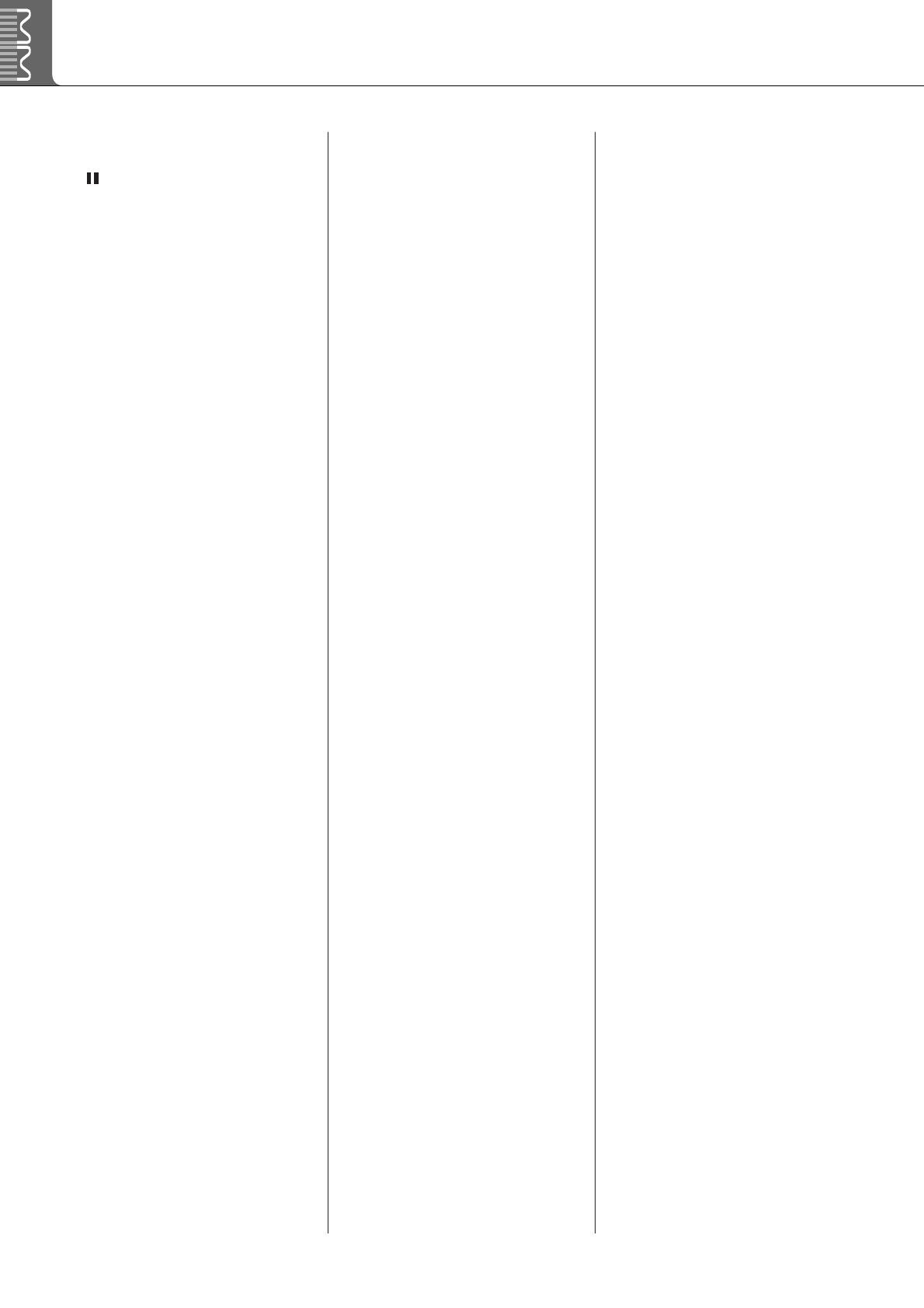
110 MM6/MM8 Owner’s Manual
[
rr
rr
] (Fast Reverse) button........... 12, 27
[
ff
ff
] (Fast Forward) button .......... 12, 27
[] (Pause) button ...................... 12, 27
[
>>
>>
/
■
] (START/STOP) button ........... 12
A
Accessories............................................ 7
[A]–[D] buttons................................... 12
[ARPEGGIO ON/OFF] button ..... 13, 20
Arpeggio Type .............................. 21, 65
Arpeggio Type List ........................... 104
Arpeggio Velocity......................... 48, 65
ATTACK............................................. 41
[ATTACK] knob................................. 12
AUTO FILL IN ................................... 51
[AUTO FILL IN] button ..................... 12
Auto-accompaniment Range............... 23
B
Backup................................................. 35
Backup Clear....................................... 35
Bank .................................................... 59
C
Cable clip ...................................... 10, 13
CATEGORY [DEC], [INC] buttons
................................................... 12, 37
CATEGORY SEARCH buttons ... 13, 15
Chord................................................... 25
Chord Basic......................................... 54
Chord Fingering ............................ 56, 65
Chorus ................................................. 43
Chorus Type .................................. 43, 65
Chorus Type List............................... 100
Computer............................................. 10
Convert (SMF Format)........................ 70
CUTOFF ............................................. 41
[CUTOFF] knob.................................. 12
D
DC IN jack .......................................... 13
[DEC/NO] button .......................... 12, 37
Delete (USB Storage Device) ............. 72
Demo ................................................... 14
Demo Cancel....................................... 65
Demonstration Song............................ 14
Dial................................................ 12, 37
Display .......................................... 12, 38
Drum Kit ............................................. 19
Drum Kit List ...................................... 90
[DRUM/PERC/SE] button .................. 19
DSP ..................................................... 44
DSP On/Off......................................... 65
DSP Type ...................................... 44, 65
DSP Type List....................................101
Dual......................................................16
[DUAL] button ..............................13, 16
Dual Voice ...........................................16
Dual Voice Chorus Level ....................63
Dual Voice Dry Level..........................63
Dual Voice DSP Level.........................63
Dual Voice Octave...............................63
Dual Voice Pan ....................................63
Dual Voice Reverb Level ....................63
Dual Voice Volume .............................63
E
[EDIT] button ................................12, 62
EDIT display........................................38
Effect Type List .................................100
Erase (Performance Memory)..............61
[EXECUTE] button .................12, 68, 69
[EXIT] button ................................12, 38
External Clock ...............................78, 79
External Clock On/Off.........................65
F
Fast Forward ........................................27
Fast Reverse.........................................27
Fill In....................................................51
[FINGER] button .................................12
Foot Controller.....................................41
FOOT CONTROLLER jack..........13, 41
Footswitch............................................41
Format (USB Storage Device).............68
Full Keyboard ......................................65
H
Headphones..........................................10
I
[INC/YES] button..........................12, 37
Initial Setup....................................65, 79
Initialization.........................................35
K
Keyboard Out...........................65, 78, 79
Knob.....................................................41
L
LCD Contrast Control..........................11
LCD CONTRAST knob ......................12
Load .....................................................71
Local ..............................................78, 79
Local On/Off........................................65
M
MAIN display................................ 38, 39
Main Section........................................ 51
Main Voice.......................................... 15
Main Voice Chorus Level ................... 63
Main Voice Dry Level......................... 63
Main Voice DSP Level........................ 63
Main Voice Octave.............................. 63
Main Voice Pan................................... 63
Main Voice Reverb Level ................... 63
Main Voice Volume ............................ 63
Master EQ List .................................... 99
Master EQ Type ............................ 48, 65
[MASTER VOLUME] control...... 12, 14
Measure Number ................................. 31
[MENU] button ....................... 12, 67, 68
Messages ............................................. 83
Metronome .......................................... 45
[METRONOME] button ............... 12, 45
Metronome Volume ...................... 46, 65
MIDI.................................................... 74
MIDI Data Format............................. 108
MIDI Implementation Chart.............. 106
MIDI IN, OUT terminals............... 13, 73
MIDI Setting........................................ 78
[MODULATION] wheel..................... 12
Modulation wheel................................ 40
Mute..................................................... 58
O
Octave.................................................. 50
OCTAVE [UP], [DOWN] buttons
................................................... 13, 50
OUTPUT R, L/MONO jacks......... 13, 73
P
Pattern............................................ 22, 51
[PATTERN] button ................. 12, 14, 22
Pattern File .................................... 69, 71
Pattern List .......................................... 98
Pattern Out............................... 65, 78, 79
Pattern Volume.............................. 53, 65
Pause.................................................... 27
PC Mode........................................ 65, 79
PERFORMANCE BANK [DEC],
[INC] buttons............................. 13, 59
Performance List ................................. 96
Performance Memory.......................... 59
PERFORMANCE MEMORY [1]–[8]
buttons ....................................... 13, 59
Personal Computer .............................. 77
PHONES jack...................................... 13
Pitch Bend Range ................................ 65
[PITCH BEND] wheel ........................ 12
Index

















































































































